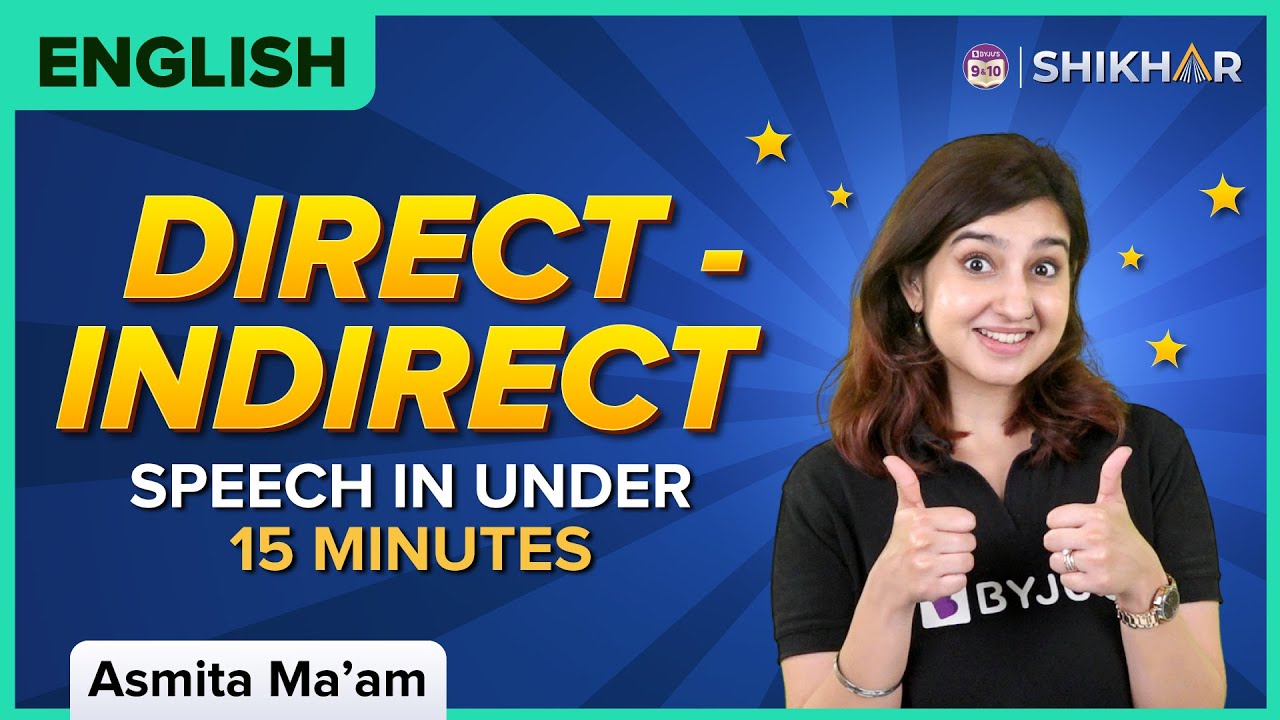6º ano - Língua Portuguesa – Vol 2 – Discurso direto e indireto
Summary
TLDRThis educational video explains the difference between direct and indirect speech in the context of news reporting. Direct speech involves quoting someone's exact words, often marked by quotation marks or dashes, ensuring authenticity. Indirect speech, on the other hand, paraphrases what a person said, presenting it in the narrator's own words. The video emphasizes the importance of these speech forms in reporting news accurately and maintaining credibility. Through examples, viewers learn to identify and differentiate between the two types of speech, as well as their use in both narratives and news articles.
Takeaways
- 😀 Direct speech (discurso direto) quotes a person's exact words, often using quotation marks or dashes.
- 😀 Indirect speech (discurso indireto) paraphrases what a person has said, without quoting them directly.
- 😀 Direct speech adds authenticity to news reports by presenting the exact words of those involved.
- 😀 Indirect speech allows for rephrasing statements, often used when the exact words are not necessary.
- 😀 The use of direct or indirect speech impacts how the news is presented, especially in conveying factual accuracy.
- 😀 Verbs of elocution (such as 'said,' 'stated,' 'explained') are key indicators of both speech types.
- 😀 In direct speech, the speaker’s words are given without alteration, maintaining the original phrasing.
- 😀 In indirect speech, the narrator restates what was said in their own words, often in the third person.
- 😀 The teacher uses an example involving César Gonçalves and his dogs to demonstrate both speech forms.
- 😀 Both types of speech are essential in journalistic writing to maintain clarity and provide context to quotes.
- 😀 Understanding the difference between direct and indirect speech is crucial for effective communication in news reporting.
Q & A
What is the difference between direct speech (discurso direto) and indirect speech (discurso indireto)?
-Direct speech is when the exact words of a speaker are quoted verbatim, often marked with quotation marks or a dash. Indirect speech involves paraphrasing or summarizing the speaker's words, where the meaning is preserved but not the exact wording.
Why is it important to distinguish between direct and indirect speech in news reporting?
-It is important because direct speech provides an accurate, verifiable account of what was said, making the information more reliable. Indirect speech may summarize the speaker's words, which can affect the interpretation of the facts.
What are 'verbo de elocução' (speech verbs) and how do they relate to direct and indirect speech?
-'Verbos de elocução' are verbs used to introduce speech, such as 'disse' (said), 'gritou' (shouted), 'respondeu' (answered). These verbs help mark the transition between direct and indirect speech and are crucial for identifying the type of speech being used.
Can you provide an example of direct speech from the transcript?
-An example of direct speech from the transcript is: 'Eu não imaginava a repercussão do registro,' disse César Gonçalves. This is a verbatim quote of what César Gonçalves said.
Can you provide an example of indirect speech from the transcript?
-An example of indirect speech is: 'César Gonçalves contou que não imaginava a repercussão do registro.' Here, the reporter paraphrases César's words without using his exact phrasing.
What role do quotation marks or dashes play in direct speech?
-Quotation marks or dashes are used to clearly indicate that the words being reported are the exact words of the speaker. This helps distinguish direct speech from indirect speech.
What impact does the use of indirect speech have on the accuracy of a report?
-Indirect speech may slightly alter the meaning or tone of the original statement, as it involves paraphrasing. While still conveying the essential information, it can be less precise than direct speech.
What is the significance of the example of César Gonçalves in the transcript?
-The example of César Gonçalves helps illustrate the use of both direct and indirect speech in real-life reporting. It shows how both forms can be used to report the same event, with direct speech providing a verbatim account and indirect speech offering a summarized version.
What is the main purpose of this lesson about direct and indirect speech?
-The main purpose of the lesson is to teach the distinction between direct and indirect speech and their application in journalism, helping viewers understand how to report speech accurately and appropriately.
How can understanding the difference between direct and indirect speech help in understanding news articles?
-Understanding the difference allows readers to discern whether the article is quoting someone verbatim (direct speech) or summarizing their words (indirect speech). This awareness helps in evaluating the credibility and accuracy of the reported information.
Outlines

This section is available to paid users only. Please upgrade to access this part.
Upgrade NowMindmap

This section is available to paid users only. Please upgrade to access this part.
Upgrade NowKeywords

This section is available to paid users only. Please upgrade to access this part.
Upgrade NowHighlights

This section is available to paid users only. Please upgrade to access this part.
Upgrade NowTranscripts

This section is available to paid users only. Please upgrade to access this part.
Upgrade NowBrowse More Related Video

Direct Indirect Speech / Kalimat Langsung dan Kalimat Tidak Langsung

Teks Berita - Definisi, Kalimat Majemuk, Kalimat Langsung dan Tidak langsung

Direct - Indirect (Reported) Speech in Under 15 Minutes | Class 9 and 10 | English | BYJU'S

KALIMAT LANGSUNG DAN KALIMAT TIDAK LANGSUNG || BAHASA INDONESIA KELAS 5 || KURIKULUM MERDEKA

Can you use REPORTED SPEECH? Grammar Lesson + Examples

Akuntansi untuk Tenaga Kerja part 1
5.0 / 5 (0 votes)